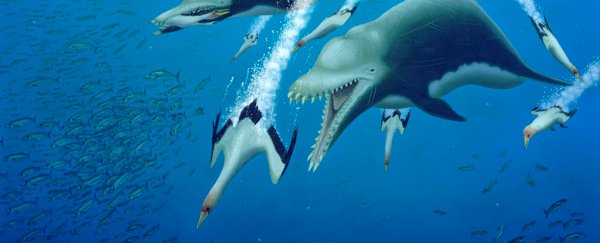Scientists have identified an almost-complete skeleton of a 4.8-metre (15.7-foot) long dolphin ancestor that lived in what is now South Carolina during the Oligocene epoch around 25 million years ago.
This 'dolphin' was the first known echolocating apex predator: as well as its large size, it would've had large, tusk-like teeth, and appears to have been capable of feeding and hunting at high speeds like an orca.
Importantly, the discovery could help us better understand how the two types of modern whales – toothed whales, such as dolphins, and baleen whales, like humpbacks – evolved their unique features, such as flippers and tail propulsion.
The skeleton was found in the 1990s but initially misclassified, and is the first nearly complete Ankylorhiza tiedemani skeleton to be analysed – previously the creature could only be studied from a partial rostrum – or snout – fossil, but now the cetacean can be much more fully understood.
One of the main revelations is that many aspects of the skeleton – the skull and tail shape, the short upper arm bone in the flipper, the shape of the teeth – suggest that the two modern types of whales, toothed and baleen, evolved many of the same features in parallel independently of each other, rather than inheriting them from the same ancestor as previously thought.
This parallel evolution occurred due to the similar aquatic environments they occupied.
"The degree to which baleen whales and dolphins independently arrive at the same overall swimming adaptations, rather than these traits evolving once in the common ancestor of both groups, surprised us," says palaeontologist Robert Boessenecker, from the College of Charleston.
"It's as if the addition of extra finger bones in the flipper and the locking of the elbow joint has forced both major groups of cetaceans down a similar evolutionary pathway in terms of locomotion."
Although it sounds obvious that animals in the same environment would evolve similar features, this isn't a pattern that's a given – different lineages of seals and sea lions, for example, each evolved their own modes of swimming and ended up with very different-looking postcranial skeletons.
The giant dolphin's time as an ancient predator ended around 23 million years ago, when it became extinct. Since then, other whales and dolphins have taken turns, but today the only echolocating whale that's also an apex predator is the orca.
Part of what makes new discovery so fascinating is that you wouldn't necessarily think about the fierce orca and the cute, modern dolphin as being all that closely linked – but Ankylorhiza would have likely fed very much like the orca does today, tens of millions of years ago.
"Whales and dolphins have a complicated and long evolutionary history, and at a glance, you may not get that impression from modern species," says Boessenecker. "The fossil record has really cracked open this long, winding evolutionary path, and fossils like Ankylorhiza help illuminate how this happened."
It was previously thought that the whales may have inherited the ability to propel themselves using their tails and steer with their flippers around 35 million years ago, Boessenecker told CNN.
More Ankylorhiza fossils are awaiting study, and the researchers are hopeful that there are many more discoveries to be made.
"Because the Oligocene epoch is the time when filter feeding and echolocation first evolved, and since marine mammal localities of that time are scarce worldwide, the fossils from Charleston offer the most complete window into the early evolution of these groups, offering unparalleled evolutionary insight," says Boessenecker.
The research has been published in Current Biology.
